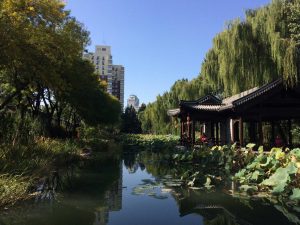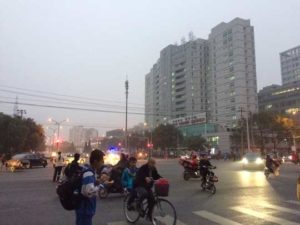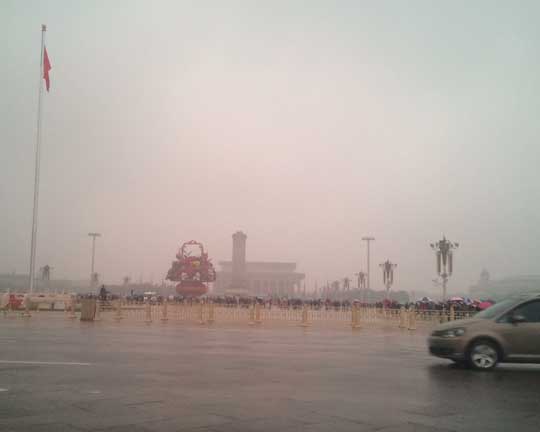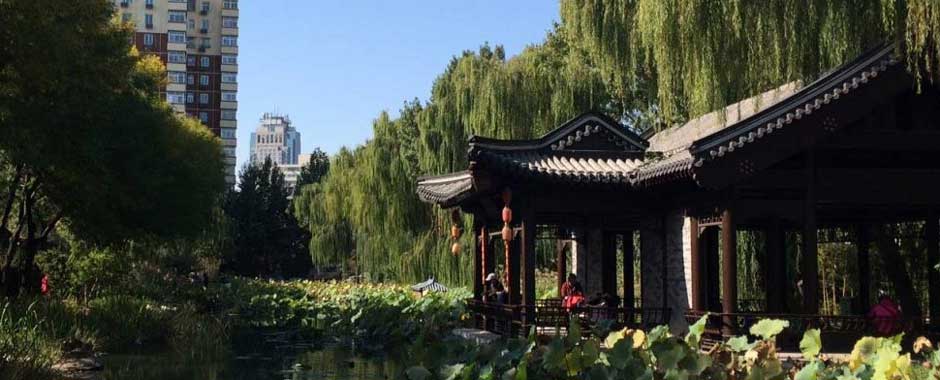The willow trees and pagodas lining the shore of the canal in a newly-built park in Jishuitan, Beijing are all meant to evoke the sights and smells of the Qing Dynasty, which ruled China for over three centuries. A park placard quotes a poem written during the reign of Emperor Qianlong, which evokes the fragrant smells of the “planted peach trees and willows”.
The park is part of Beijing’s municipal “Second Ring Road Greenway belt” – an inter-connected, circular green belt that will run through four of Beijing’s districts once it is completed.

It’s all part of China’s larger, long-term ambitious plan to become more environmentally sustainable. China’s 13th Five Year Plan, which runs from 2016 – 2020, promotes low carbon industries, green finance, environmental monitoring and CO2 emission permit systems. It also sets out a number of initiatives to reduce smog and air pollution and carbon dioxide emissions. They include reforming coal fired plants and eliminating outdated processes.
A vision for China’s construction of an “ecological civilisation” is further developed in an accompanying state policy document that sets out standards, mechanisms and reforms that aim to improve environmental governance.
The obvious reason the Chinese government has adopted this approach is clear within two steps away from the park. Beijing’s roads are jammed with traffic and the sun obscured by the smog-filled grey skies overhead. Residents in polluted Chinese cities are becoming increasingly vocal about the negative impacts of this existence on their health and well being.

While these developments have the potential to have a positive impact on China’s environment and its people, some people are being hit hard by China’s green transformation. Take China’s cement industry as an example, which produces 60% of global cement. Much of the cement has been produced in small, polluting coal-fired plants.
In December 2013 there were over 100 privately owned cement factories in Luquan township, a district in southwestern Shijiazhuang, Hebei province, which has a number of private and state-owned cement factories employing thousands of workers. In the course of six months – from September 2013 to February 2014 – 24 privately-owned cement factories in Luquan township were shut down by the government, resulting in the loss of 2,500 jobs, according to a Luquan government report.
Chulin Jiang, a PhD student at Beijing Normal University, shared findings from her research on the cement factory closures at a conference held in Beijing on the Governance of China’s Green Transformation, organised by the STEPS China Sustainability Hub. Jiang believes that the resulting unemployment numbers are much higher, potentially affecting as many as 7,000 people, as the government statistics don’t take into account the small businesses that relied on the cement factory workers to survive, such as local restaurants and hairdressers.
Those laid off workers are now either travelling 30 – 40 km away to Shijiahuang, Hebei’s largest city, or to Dahe township, a 15 – 20 km journey, to look for work each day at informal labour markets. Women hired to do cleaning and lifting work might earn around 80 – 90 Yuan or around £11/day, while men might earn around 100 – 120 Yuan or around £14/15/ day.
Jiang carried out interviews with laid off cement workers, former cement factory owners, government officials and village committee members in the township. Many of the individuals Jiang interviewed have said that the social impacts of the factory closures were not adequately taken into account in the policy design and implementation process. “People have lost their jobs and there’s no policy to address the situation to give them the support they need,” she said. No workers she has spoken to have received any retraining.
Workers and factory owners also said that the speed of the closures gave them very little buffer time to plan alternative livelihoods. “They were surprised at how quickly the policies were implemented,” said Jiang. “It’s not just about the shutting down”, she said. “You have to consider the alternatives.”
Individuals affected were also not given the opportunity to express their opinions about the closures as there was no public hearing about it or to help people being to think about alternatives. A China Central TV Channel 2 report on the closures invited government officials and cement factory owners to be interviewed for the programme, but no cement workers, according to Jiang.
While the official reason cited for the closures was the need to cut cement industrial overcapacity in Luquan district, the objective of the closures was unclear and conflicting, said Jiang. By conducting the closures so quickly, the government met the target of cutting cement overcapacity three years ahead of the original deadline.
However, former cement factory owners told Jiang that business was good. Ironically, some cement factory owners had upgraded their equipment to be less polluting and met the new environmental requirements prior to being asked to close down. They didn’t believe that the factories were closed in order to ease overproduction, but rather due to political pressure exerted by urban residents – mostly Beijing residents – fed up with smog and air pollution.
In general, the laid off cement factory workers seem to have accepted their fate, said Jiang. The residents of Hebei province are geographically close to Beijing. “The closer to the Emperor, the more obedient people become,” said one workshop participant. Challenging the Chinese government is risky, but challenging a government that is 100 km away is even more risky.

But perhaps it’s as difficult to challenge the new environmental discourse because it is one that promotes the collective good. Putting ones individual needs before that in China is never going to be easy.
The research reminds us that while there will be a lot of winners in the coming decades if China succeeds in implementing its green reforms to transition to a cleaner, greener economy, there will be environmental losers too.
Find out more about the China Sustainability Hub and the Pathways Network, which is conducting research on the cement industry in Hebei province, China.
